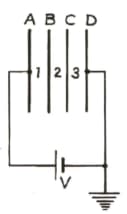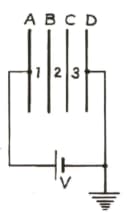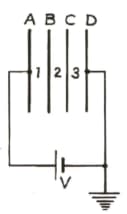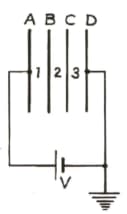Redistribution of Charges : Common Potential (Optional)
Important Questions on Redistribution of Charges : Common Potential (Optional)
A, B, C and D are four ‘thin’, similar metallic parallel plates, equally separated by distance d and connected to a cell of PD V as shown.

Will the charges on the plates A and D change?
A, B, C and D are four ‘thin’, similar metallic parallel plates, equally separated by distance d and connected to a cell of PD V as shown.

How will the electric fields change in the spacings between the plates ?
A, B, C and D are four ‘thin’, similar metallic parallel plates, equally separated by distance d and connected to a cell of PD V as shown.

If B and C be connected by a wire, then what will be the potentials of the plates?
A, B, C and D are four ‘thin’, similar metallic parallel plates, equally separated by distance d and connected to a cell of PD V as shown.

Write the potentials at A, B, C and D.
If we hold in hand the wires connected to the plates of a charged capacitor, we feel electric shock. The shock from a capacitor is more intense than that from a capacitor, both at the same potential. Why?
Two charged conducting spheres of radii a and b are connected to each other by a wire. Find the ratio of electric fields at the surfaces of the spheres.
A big metallic sphere is connected by a wire to an external smaller sphere. This arrangement is given some charge: Which will have a higher surface density of charge?
A big metallic sphere is connected by a wire to an external smaller sphere. This arrangement is given some charge: Which sphere will take more charge?
The potentials of two charged conductors are and their capacitances are and respectively. When these are connected by a wire, the changes in their potentials are and respectively. Prove that .
Prove that if two charged conductors are touched mutually and then separated, the charge on them will be divided in the ratio of their capacitances.
Two capacitances and are connected in parallel. If a charge Q be given to this system, in what ratio will it be distributed on them? If the capacitances were connected in series, then?
Can there be a potential difference between two close conductors of the same volume carrying equal positive charges?
Two copper spheres of equal radii, one hollow and the other solid are charged to the same potential. Which one does carry more charge?

